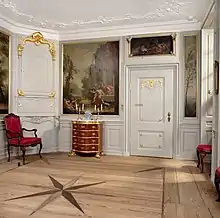Schäffer House
The Schäffer House is an 18th-century, bourqoise townhouse located at Magstræde 6 in the Old Town of Copenhagen, Denmark. The building is also called Hofsnedkerens Gård after Diderich Schäffer for whom it was built. Schäffer's interior Rococo decorations from the first floor are now on display in the National Museum as part of the Magstræde Apartment.
| Schäffer House | |
|---|---|
Hofsnedkerens Gård | |
 The Schäffer House | |

| |
| General information | |
| Architectural style | Baroque |
| Location | Copenhagen, Denmark |
| Coordinates | 55°40′35.63″N 12°34′32.75″E |
| Construction started | 1733 |
| Completed | 1734 |
| Client | Diderich Schäffer |
| Design and construction | |
| Architect | Philip de Lange |
History
Diderich Schäffer
The property (then No. 43) was in 1689 owned by a brewer named Henrik Andersen.
Diderich Schäffer was called to Denmark in circa 1730 to work on Christiansborg Palace. The house in Magstræde was built for him by Philip de Lange in 1733–34. He lived in the ground floor and had his workshop in the rear wing and possibly part of the side wing. The more elegant apartment on the first floor was rented out.
In 1755–56, Schäffer constructed the country house Schæffergården at Jægersborg north of Copenhagen. His plan was to sell it but it proved difficult and he ended up owning it until 1771.[1] He died in 1778.
Johan Gierløf
.png.webp)
The property was on 11 June 1749 sold to Johan Gierløf. Johan Gierløf (1709-1800)He was the fifth son of brewer r Chr. Gierløf and Rachel Jørgensdatter. He had together with his brother Christian continued the family's brewery in Vestergade but they had both turned to porcelain. Johan Gierløf had started a lucretive import of porcelain from Saxony while the brother had become the proprietor of Store Kongensgade Faience Manufactury. On 5 April 1759, Gierløf was lixensed as a wholesaler (grosserer). In 1768, he purchased a property in Stormgade but without parting with the house in Magstræde..[2]
The historian and civil servant Ove Malling lived in the building from 1776 to 1780. The naval officer Peder Norden Sølling lived in the building in 1787–88. He is most notable for founding Bombebøssen in Christianshavn.
Johan Gierløfkept the house in Magstræde until his death in 1800.
19th century
The property was in the new cadastre of 19+7 listed as Snaren's Quarter, No. 30. It was by then still owned by Gherløf's heirs.
At the time of the 1840 census, Snaren's Quarter, No. 30 was home to a total of 39 people.[3] At the time of the 1860 census, it was home to a total of 31 people.[4]
Architecture

The house is five bays wide and has a three-bay central projection. The rounded pediment was added in 1850.[5] The rear side of the building is built with exposed timber framing.
The gateway opens to a long, narrow courtyard. A 13 bay long side wing with exposed timber framing extends from the rear side of the building along the left-hand side of the courtyard. A rear wing is located at the bottom of the courtyard.
Interior

Schäffer's rich interior Rococo decorations from his house are now on display in the National Museum.[6][7]
References
- "Dietrich Schäffer" (in Danish). Dansk Biografisk Leksikon. Retrieved 27 November 2016.
- Frederik Hjort. "Slægten Gjerløff med dens Spindelinier gjennem cirka tre Hundrede Aar" (PDF). slaegtsbibliotek.dk (in Danish). Retrieved 31 January 2021.
- "Folketælling - 1840 - Magstræde No 30". danishfamilysearch.dk (in Danish). Retrieved 28 January 2021.
- "Folketælling - 1860 - Magstræde No 30". danishfamilysearch.dk (in Danish). Retrieved 28 January 2021.
- "Magstræde 6-6a-b". indenforvoldene,.dk (in Danish). Retrieved 26 November 2016.
- "Borger under enevælden" (in Danish). Nationalmuseet. Retrieved 27 November 2016.
- "Magt under enevælden" (in Danish). Nationalmuseet. Retrieved 27 November 2016.
External links
| Wikimedia Commons has media related to Hofsnedkerens Gård. |
- Magstræde 6 at indenforvoldene.dk